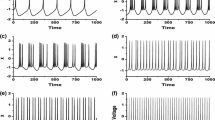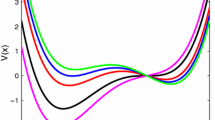Summary
Mathematical models for excitable membranes may exhibit bursting solutions, and, for different values of the parameters, the bursting solutions give way to continuous spiking. Numerical results have demonstrated that during the transition from bursting to continuous spiking, the system of equations may give rise to very complicated dynamics. The mathematical mechanism responsible for this dynamics is described. We prove that during the transition from bursting to continuous spiking the system must undergo a large number of bifurcations. After each bifurcation the system is increasingly chaotic in the sense that the maximal invariant set of a certain two-dimensional map is topologically equivalent to the shift on a larger set of symbols. The number of symbols is related to the Fibonacci numbers.
Similar content being viewed by others
References
J. C. Alexander and D. Cai, On the dynamics of bursting systems, J. Math. Biol.29, 405 (1991).
P. M. Beigelman, B Ribalet, and I. Atwater, Electrical activity of mouse pancreaticβ-cells II. Effects of glucose and arginine, J. Physiol. (Paris)73 (1977), 201–217.
T. R. Chay, Chaos in a three-variable model of an excitable cell, Phys. D. 16 (1985), 233–242.
T. R. Chay and J. Keizer, Minimal model for membrane oscillations in the pancreatic beta-cell, Biophys. J.42 (1983), 181–190.
T. R. Chay and J. Rinzel, Bursting, beating, and chaos in an excitable membrane model, Biophys. J.47 (1985) 357–366.
B. Deng, Homoclinic bifurcations with nonhyperbolic equilibria, SIAM J. Math. Anal.21 (1990), 693–720.
N. Fenichel, Persistence and smoothness of invariant manifolds for flows, Indiana Univ. Math. J.21 (1971), 193–226.
J. Gukenheimer and P. Holmes,Nonlinear Oscillations, Dynamical Systems, and Bifurcations of Vectors Fields, Springer-Verlag, New York (1986).
A. L. Hodgkin and A. F. Huxley, A quantitative description of membrane current and its application to conduction and excitation in nerve, J. Physiol. (London)117 (1952), 500–544.
H. P. Meissner, Electrical characteristics of the beta-cells in pancreatic islets. J. Physiol. (Paris)72 (1976), 757–767.
J. Moser,Stable and Random Motions in Dynamical Systems, Princeton University Press, Princeton (1973).
C. Morris and H. Lecar, Voltage oscillations in the barnacle giant muscle fiber, Biophys. J.35 (1981), 193–213.
J. Rinzel,Bursting oscillations in an excitable membrane model, inOrdinary and Partial Differential Equations (B. D. Sleeman and R. J. Jarvis, eds.), Springer-Verlag, New York (1985), 304–316.
J. Rinzel and G. B. Ermentrout, Analysis of neural excitability and oscillations, inMethods in Neuronal Modeling, From Synapses to Networks, (C. Koch and I. Seger, eds.), MIT Press, Cambridge, MA (1989), 135–169.
A. M. Scott, I. Atwater, and E. Rojas, A method for the simultaneous measurement of insulin release and beta-cell membrane potential in single mouse islet of Langerhans, Diabetologia21 (1981), 470–475.
A. Sherman, J. Rinzel, and J. Keizer, Emergence of organized bursting in clusters of pancreaticβ-cells by channel sharing, Biophys. J.54 (1988), 411–425.
D. Terman, Chaotic spikes arising from a model for bursting in excitable membranes, SIAM J. Appl. Math.51 (1991), 1418–1450.
S. Wiggins,Global Birfurcations and Chaos: Analytic Methods, Springer-Verlag, New York, Heidelberg, Berlin (1988).
Author information
Authors and Affiliations
Additional information
Communicated by Stephen Wiggins
Rights and permissions
About this article
Cite this article
Terman, D. The transition from bursting to continuous spiking in excitable membrane models. J Nonlinear Sci 2, 135–182 (1992). https://doi.org/10.1007/BF02429854
Received:
Accepted:
Issue Date:
DOI: https://doi.org/10.1007/BF02429854




